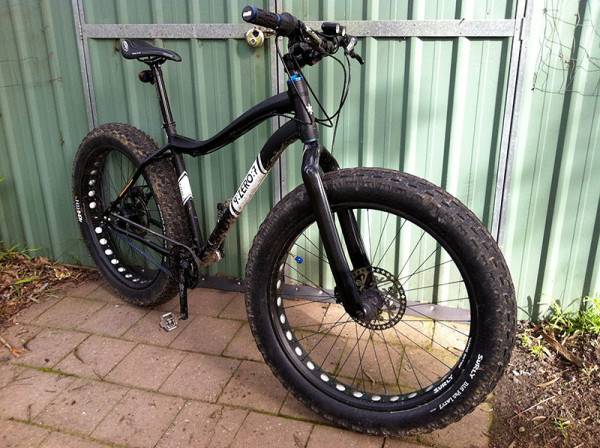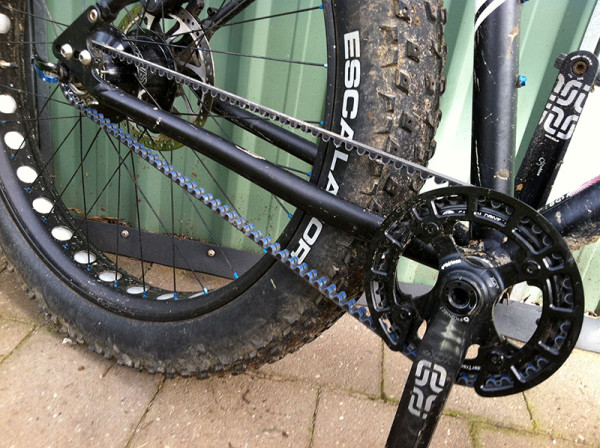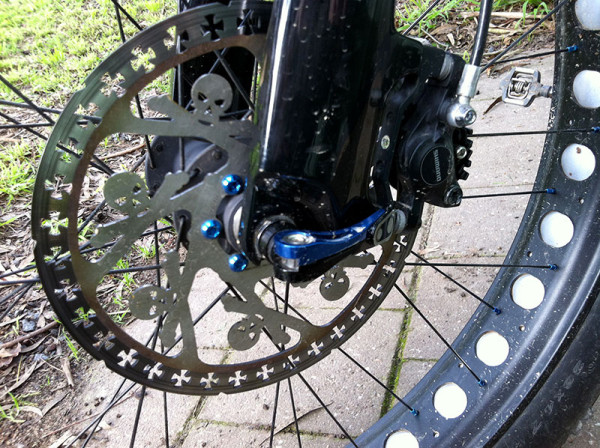Australian, Euan Pennington, originally published this story on his blog and let us know about that but we thought it was so good that we asked him if we could share it with you all. So, here it is!
When it came to acquiring a new bike, as a bike nerd I had many thoughts, hopes and dreams. I wanted a bike that was fun enough to ride everyday, light enough to throw in a box and take travelling, versatile enough to be an explorer overseas, strong enough to be reliable in remote conditions and agile enough to rip up choice singletrack. As a fat-bike owner of a few years standing, I knew the build would be fat, so all I had to really sort out was every other detail. There was nothing out there that really fitted the bill, so I decided this would be a ground up custom build. Having built bikes before I have learned that it is always best to build from the ground up – once I built from the seat down but made an error in my measurements, and ended up with the wheels not reaching the ground – embarrassing!
A meeting with Damien from the Cog Bike Café in Warburton, (outside Melbourne, in Australia), saw a plan hatched, and as the photos attest, months of head scratching have produced quite a machine, ticking all the above boxes, and more.
The frame is a 9:ZERO:7 aluminium 135mm offset sliding dropout model, with a Carver Carbon O Beast fork nailed on the front for extra lightness and carbony goodness. Between the dropouts at the front is what we believe is the first White Industries Sno White front hub to grace the shores of the Antipodes, and it has been laced to the ever reliable epic tested 82mm Holy Rolling Darryl rim. Wrapping Darryl is an ultralight Big Fat Larry, again for added lightness, whilst the tyre at the back, for speed and agility, is a small and featherweight 45Nrth Escalator; only 3.8 inches and 1240 grams. Both tyres are set up tubeless, for that light and puncture resistant feel.
Where things get more interesting is the drive train. Taking inspiration from motorsport, who keep all their gears and expensive moving parts in a small box full of oil, rather than hanging it out in the breeze to be damaged by rocks and mud and misuse, a Rohloff internally geared hub has been used, and to save weight and reduce moving parts, (and thus wear and maintenance), this is driven by a Gates Centre Track carbon belt drive. Other parts include XT brakes, and a garnish of Thompson aluminium, to round out a package that weighs in at a touch under 13 kg, or 28.5 pounds if you still speak Roman Catholic.
Which is all well and good, but how does it ride? Well, it goes like a cut cat, and the XT brakes stop like a brick wall taken under the influence of a bottle of tequila. Whilst it looks like a fat-bike, and when cruising rides like a (nice) fat-bike, the lack of weight, especially in the front end, as well as the handling, float and grip means that when you give this bike a spanking it just sits up and barks, asking for more. It particularly shines in nasty, chopped up and unpleasant terrain, which it shrugs off with little concern. So much fun, it has you looking for things real people think are unfun, because the rules have changed, and unfun is no longer the case. Honestly, I’m surprised it’s legal. It’s when the going gets tough that this thing starts to really show its colours. Which are black, so not a good metaphor there.
Of course there are those out there who will be salivating to hear about the gearing, and all I can say is go and buy this set up, derailleurs, (a French word for expensive), are sooo last century. Same gear spread as 3 by 9, less one gear, (so more than 2 by 9, or 1 by 10), but smooth, quick changes and absolute reliability. There is a learning curve in the shifting that I am still getting used to, but it is not a problem, just a new thing to adapt to. The hub is also a little noisy and clunky until it is run in – at about 1500 kilometers. Yes, as most drive trains are starting to give up, this thing is only just getting started. There are Rohloffs out there with over 100 000 km on them; put this in your will, it’s an investment, not a consumable. The belts are not so robust, talk on the Wide World of Web suggest if well cared for and not damaged, perhaps only 10 – 20 000 kays is an expected lifespan. Hmm, limiting… Meanwhile, there is no chain suck, no dry and complaining chain, no compromised chain line…. No chain at all, just a belt unaffected by rain, mud and sand.
The Web is full of commentary about set ups like this, many are negative, but I suggest firstly, as many commentators haven’t, build the system correctly, then ride it long term. It takes time to get used to, and should be approached with an open mind. Beware, though, let it get under your skin and you will soon be a convert to strength and simplicity personified.
All in all I couldn’t be happier with this bike – light, robust, fast and well handling, and you can even change gears standing still. Should someone ask me to go and cross the Atacama Desert tomorrow, I happily would say “yes”, knowing the bike would be comfortable and reliable. To prove it, if someone could just send me an air ticket to Peru…Thanks to Damo from Cog Bike Café for all his work and advice, and I look forward to seeing you out on the trails somewhere. Stop reading now – so often when all is said and done, more is said than done, so put down the computer and go riding. I’ll see you out there.
You can read more from Euan on his blog at http://madnotto.wordpress.com.
Do you have a fat-bike that you are passionate about, makes your like better and that you think our readers would dig hearing about? Shoot me a note to greg@fat-bike.com and we will check it out.




No comments yet.